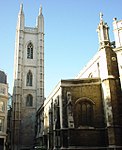Mansion House tube station

Mansion House is a London Underground station in the City of London which takes its name from Mansion House, the residence of the Lord Mayor of London. It opened in 1871 as the eastern terminus of the Metropolitan District Railway. Today, Mansion House is served by the Circle and District lines. It is between Blackfriars and Cannon Street stations and it is in fare zone 1. The station is located at the junction of Queen Victoria Street and Cannon Street. Mansion House is a sub-surface station with three platforms. The westbound platform, number 1, and the eastbound platform, number 3, are shared by both the Circle and District lines. A third platform was used for terminating eastbound trains, however it is no longer used and the track removed as services continue and terminate at Tower Hill. Despite the station's name, it is not the nearest tube station to Mansion House itself, which is in fact directly opposite an entrance to Bank station. Moreover, two other stations on the same District and Circle lines (Cannon Street and Monument) are also nearer to Mansion House than its namesake.
Excerpt from the Wikipedia article Mansion House tube station (License: CC BY-SA 3.0, Authors, Images).Mansion House tube station
Queen Victoria Street, City of London
Geographical coordinates (GPS) Address Nearby Places Show on map
Geographical coordinates (GPS)
| Latitude | Longitude |
|---|---|
| N 51.5122 ° | E -0.0941 ° |
Address
Queen Victoria Street 63
EC4N 4UA City of London
England, United Kingdom
Open on Google Maps










